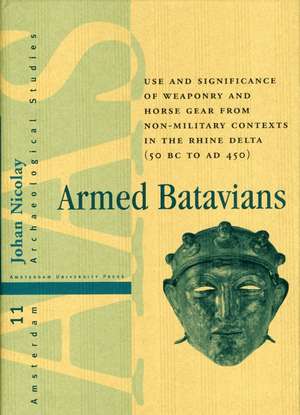Armed Batavians – Use and Significance of Weaponry and Horse Gear from Non–military Contexts in the Rhine Delta (50 BC to AD 450): Amsterdam Archaeological Studies
Autor Johan Nicolayen Limba Engleză Hardback – 13 noi 2007
Using a life-cycle model for Roman soldiers, Johan Nicolay interprets the large quantity of first-century finds as personal memorabilia brought home by ex-soldiers as a reminder of their twenty-five years of service and a symbol of their newly-acquired veteran status. Underpinning Nicolay’s research is an extensive inventory of militaria from urban centers, rural settlements, rivers, and graves—presented in nearly one hundred individual color plates. Introducing a considerable body of unpublished data, as well as offering a perspective on daily life in the northern frontier of the Roman Empire, this volume is a valuable addition to Roman military and material history.
Preț: 664.23 lei
Preț vechi: 1028.64 lei
-35% Nou
Puncte Express: 996
Preț estimativ în valută:
127.14€ • 138.15$ • 106.87£
127.14€ • 138.15$ • 106.87£
Carte indisponibilă temporar
Doresc să fiu notificat când acest titlu va fi disponibil:
Se trimite...
Preluare comenzi: 021 569.72.76
Specificații
ISBN-13: 9789053562536
ISBN-10: 9053562532
Pagini: 424
Ilustrații: 120 halftones
Dimensiuni: 210 x 297 x 29 mm
Greutate: 2 kg
Editura: Amsterdam University Press
Seria Amsterdam Archaeological Studies
ISBN-10: 9053562532
Pagini: 424
Ilustrații: 120 halftones
Dimensiuni: 210 x 297 x 29 mm
Greutate: 2 kg
Editura: Amsterdam University Press
Seria Amsterdam Archaeological Studies
Notă biografică
Johan Nicolay is a researcher at the Groningen Institute of Archaeology at the University of Groningen.
Cuprins
Preface
1. Introduction
1.1 Background, objectives and development of the research
1.2 Geographical context and specific characteristics of the research region
1.3 'Military' and 'civilian' during the Roman period
2. Military Equipment and Horse Gear: A Survey
2.1 Miltary equipment
2.2 Horse gear
2.3 Phasing and historical context
3. An Analysis of the Finds at the Regional and Site Level
3.1 Chronological analysis
3.2 Geographical analysis
3.3 Composition and spatial distribution at the site level
3.4 Conclusion
4. Production and Symbolic Imagery
4.1 The production of weaponry and horse gear
4.2 Decoration and symbolism
4.3 Conclusion
5. Military Equipment and the Life Cycle of a Roman Soldier
5.1 The life cycle of a Roman soldier
5.2 Use of weaponry and horse gear during the life of a soldier
5.3 Types of social use in the different non-military contexts
5.4 Conclusion
6. Non-Military Use of Weaponry and Horse Gear in Urban and Rural Settlements
6.1 The bearing of arms by non-soldiers
6.2 Military-civilian use of the cingulum and baldric
6.3 Non-miltary uses of horse gear
6.4 Conclusion
7. Warriors, Soldiers, and Civilians. Use and Significance of Weaponry and Horse Gear in a Changing Socio-Political Context
7.1 The pre-Roman situation: the importance of warriorship
7.2 Consequences of the Roman takeover: continuity and discontinuity of late Iron Age traditions
7.3 A 'civilian lifestyle' at the imperial frontier
7.4 'Germanic' newcomers and a revival of marital values?
7.5 Conclusion
Abbreviations
Bibliogaphy
Appendices 1-4
About the plates and the catalogue
Plates 1-96









